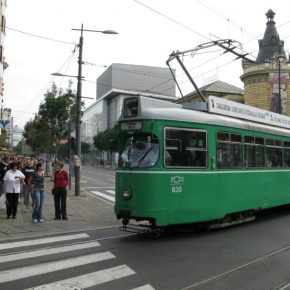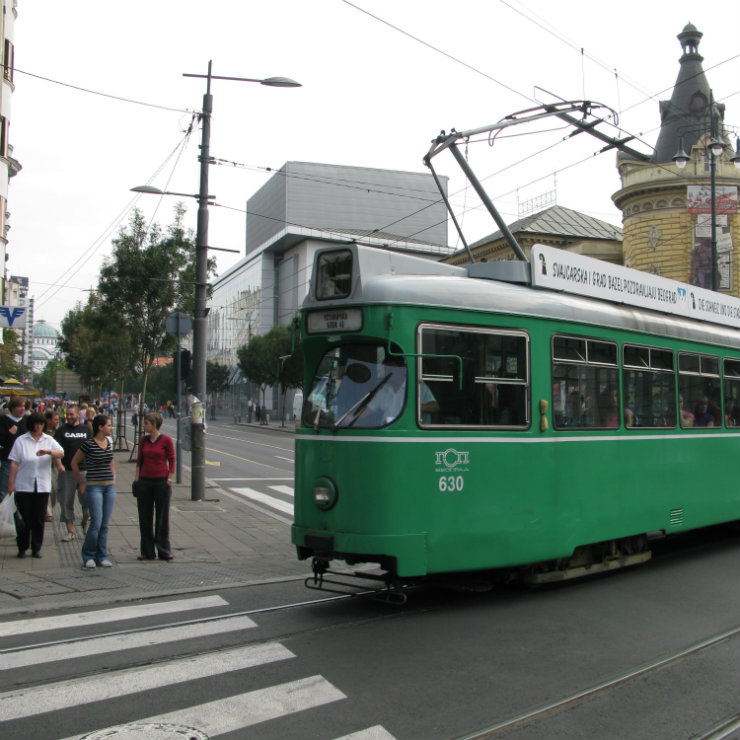
Belgrade, Serbia (Marko Kudjerski, CC BY)
Further growth in spending will result in an increase in employment rates and wage growth, stronger consumer credit, and higher budget spending. When it comes to inflation, the banks expect to reach 2 per cent by autumn, on the basis of labor market strengthening, higher consumer goods prices and stronger domestic demand, supported by fiscal expansion and private sector development, but the average inflation rate in 2018 will be lower and will amount to 1.8 per cent.
The banking groups estimate that further growth in demand for investment, imports of consumer goods and higher commodity prices will lead to a moderate trade deficit this year of around 11 per cent of GDP, but record foreign workers’ remittances and a decrease in the investment deficit will slightly reduce it to 5.5 per cent of GDP. They also forecast that the first increase in the reference interest rate of the National Bank of Serbia (NBS) will be achieved only in the Q1’20 (for 25 basic points, due to the unexpected external impact of softened base inflation in Serbia and the foreseeable normalization of monetary policy by the FED and the European Central Bank points).
Thanks to a steady increase in tax revenues, fiscal discipline has been maintained in the H1’18, following a high budget surplus of 1.2 per cent of GDP in 2017. However, analysts estimate that the budget surplus will drop to 0.5 per cent of GDP in 2018 due to the acceleration of capital expenditure growth and wage and salary increases. When it comes to the credit activity of banks in Serbia, they expect it to grow by 8.0 per cent this year. Thanks to solid fiscal consolidation, stronger GDP growth, sustainable primary surplus and stronger RSD, a further reduction of public debt is expected at a level of 57.5 per cent of GDP, which opens the way for strengthening the rating of the country.
Serbian Prime Minister Ana Brnabić considers these achievements as a “fantastic result” and announced a possibility of a salary raise in public sector and higher pensions. Still, this result falls short of the expected ones. „Fantastic news” is that in the H1’18, the GDP grew by 4.5 instead of 3.6 per cent, as projected earlier. The Minister of Finance, Siniša Mali says that “this is the best result in the first half of the past ten years!” Both Ms. Brnabić and Mr. Mali assure that there is a space for bigger and faster increase in salaries and pensions. „This gives us more space for a somewhat earlier increase in wages and pensions, or the abolition of the law on temporary pensions reduction, but also a somewhat larger area in thinking about a higher salary increase in the public sector,” Ms. Brnabić said.
The Minister of Finance stresses that the growth is diversified, i.e. noticeable in all sectors and that these results confirm the responsibly implemented reforms in the previous period. It emerged that Serbia recorded significantly higher economic growth than the average in the countries of the region and the European Union and that a positive contribution continues to provide all production sectors, primarily service and construction activity.
Mr. Mali pointed out that the strongest growth was achieved in the construction sector (23.1 per cent) as a result of infrastructure projects run by the state, as well as the strengthening of private construction activity. „It is particularly praiseworthy that there is a noticeable growth in all sectors, from construction to agriculture, and this is precisely the fact that Serbia has become a country with stable economic growth and public finances,” he stressed. He pointed out that the growth of trade, tourist services, as well as the steady increase in the ICT sector, provided a year-on-year growth in the service sector of 3.4 per cent. Mr. Mali said that a good agricultural season, according to the Ministry of Finance estimates, provides a growth of this activity of 11.7 per cent in the Q2. As he said, industrial production recorded an increase in the physical volume of 2.5 per cent compared to the same period of the previous year, driven by the growth of the manufacturing industry, especially in the production of basic metals, the machine and the recovered food industry.
The European Bank for Reconstruction and Development (EBRD) predicts that Serbia’s economic growth will be 2.9 per cent in 2018, and 3.5 per cent in 2019. EBRD analysts recall that the economic growth of Serbia slowed down last year to 1.9 per cent after the growth of 2.8 per cent a year earlier, due to the agricultural sector and the drought, as well as problems in the mining and energy sector. Fiscal performance continued to record better results than projected, so in the past few years, the budget deficit of 6.6 per cent of GDP from 2014 has been converted into a surplus of 1.2 per cent of GDP in 2017, while public debt fell below 65 per cent of GDP by the end of 2017, according to the report.
The Serbian economists explain that GDP growth is the mostly „triggered” by the construction industry, but to sustain it, it is necessary to continue this a trend. Construction grows over 20, 25 per cent in the Q1, and the industry is growing by more than 4 per cent — it’s a little lower than Serbian economy expected. This somewhat faster growth was quite certain, primarily driven by a rise in agriculture, but can the Serbian economy keep this growth in 2019 is a key dilemma. Although the government claims that Serbia has a higher economic growth at this moment than even the EU average, Serbian growth is far below the European average and even the region’s average. For example, in theQ1 — Hungary, Romania, Estonia, Poland, the Czech Republic — had over 4 per cent growth, and Romania had 7 per cent for the whole year, which is hardly achievable by Serbia now. If Serbia wants to catch up with other countries in the region and Europe, a constant growth of 5 per cent and more is needed.
Currently, the NBS holds talks with the IMF mission in Belgrade. Main topics of discussions include the current economic, monetary and fiscal developments in the country, as well as projections of macroeconomic indicators for this and next year. On July 18th, the Policy Coordination Instrument, was approved but it is of advisory nature and does not foresee the use of the financial resources of the International Monetary Fund and does not have any costs for Serbia.
The main challenges facing Serbia are: stagnant household incomes, a need for private sector job creation and structural reform of public enterprises, as well as strategic reforms in the public sector. An ineffective judicial system, a high level of corruption and an aging population represent other challenges that the country will have to face in the long term.
Vedran Obućina is an analyst and a journalist specializing in the Croatian and Middle East domestic and foreign affairs. He is the Secretary of the Society for Mediterranean Studies at the University of Rijeka and a Foreign Affairs Analyst at The Atlantic Post.


